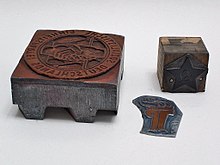Cliché (printing technology)
In newspaper and letterpress printing technology, a cliché (also known as cliché ) is a photochemical or machine-made printing form for the relief printing process .
material
A cliché can be made of zinc , copper , plastic or, in modern flexographic printing, of photopolymer. In the 1950s to 1970s there were also clichés made of aluminum and magnesium in book printing , but these did not catch on. In order to achieve higher editions of the same cliché, galvanic surface finishes are also used, the production of which is called stealing .
Metal or plastic plates are provided with a light-sensitive layer. The motif to be printed is exposed using negative film . The exposed parts of the layer harden, while the unexposed parts remain water-soluble. In the case of metal clichés, the cliché etcher deepens the non-printing part by removing material during the subsequent etching process , while the exposed part remains increased. In the case of zinc, the etching agent consists of dilute nitric acid , in the case of copper clichés iron (III) chloride . In the 1960s, electronic clichés were also used for the production of letterpress clichés made of zinc.
For four-color printing , sets of clichés were used in which each cliché contained a certain color of the image through photographic or electronic color separations . Color sets with the primary colors magenta , cyan and yellow as well as the drawing color black were common . From the 1970s onwards, letterpress clichés became increasingly less important due to more efficient printing techniques such as offset , flexographic or gravure printing .
Today's procedures
Photopolymer printing plates are either cast from liquid resin , the monomer with additives such as photoinitiators, or supplied as unexposed flexographic printing plates. The underside of the cliché is hardened with a back exposure. Then the printing parts of the printing form are transferred to the layer side of the plate with the aid of a negative film and cured ( polymerized ) by UV exposure . The non-printing areas are washed out with solvents such as water or naphtha and alcohol .
As an alternative to photomechanical cliché production, electronic direct laser engraving is also used for flexographic printing , in which a laser beam cuts out the non-printing areas from the cliché. To do this, the computer-controlled laser beam axially scans the rotating cliché mounted on a printing cylinder and leaves the motif to be printed raised. After a finishing process, the resulting printing form is mounted on a carrier sleeve or the printing cylinder with the help of double-sided adhesive tape or magnetism (by adding iron filings to the plastic compound ) .
Clichés for pad printing are produced either photo-chemically or by laser ablation. Depending on the type of motif and the number of copies, aloxide, plastic, steel band, solid steel or ceramic clichés are used.
literature
- Hubert Blana: The production. A manual for the design, technology and costing of books, magazines and newspapers. 4th revised and expanded edition. KG Saur Verlag, Munich 1998, ISBN 3-598-20067-6 ( basic knowledge of the book trade - publishers 5).
- Helmut Kipphan (Hrsg.): Handbuch der Printmedien. Technologies and production processes. Springer, Berlin et al. 2000, ISBN 3-540-66941-8 .
- Karl-Heinz Meyer (Ed.): Technology of flexographic printing. Published in cooperation with DFTA, Deutschsprachige Flexodruck-Fachgruppe eV 5th revised and expanded edition. Rek & Thomas Medien, St. Gallen 2006, ISBN 3-905330-17-2 .
- Hans Jürgen Scheper: Examination knowledge printing technology. Prepress, postpress. Verlag Beruf und Schule, Itzehoe 2005, ISBN 3-88013-623-8 .

